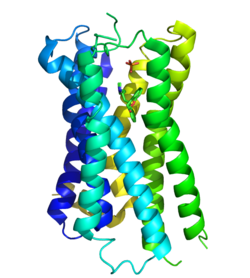Histamine H 1 receptor
| Histamine H 1 receptor | ||
|---|---|---|

|
||
| Structural model of the histamine H 1 receptor in complex with doxepin | ||
| Properties of human protein | ||
| Mass / length primary structure | 487 AS ; 55.8 kDa | |
| Secondary to quaternary structure | 7TM | |
| Identifier | ||
| Gene name | HRH1 | |
| External IDs | ||
| Occurrence | ||
| Parent taxon | Vertebrates | |
The histamine H 1 receptor (abbreviated H 1 receptor ) is a protein from the family of histamine receptors that by the body's tissue hormone histamine can be activated. The H 1 receptor is widespread in the human body and occurs, for example, in the cell membrane of cells of the immune system , such as mast cells , smooth muscles and in nerve cells . The most important functions of this receptor include mediating the allergy-like effects of histamine and neurotransmission . It is a G protein-coupled receptor .
biochemistry
genetics
The human H 1 receptor was first cloned in 1995 . It is encoded by a gene on chromosome 3 on the gene locus 3q25. The coding DNA sequence is intron-free .
Protein structure
The human H 1 receptor protein consists of 487 amino acids . With the help of the X-ray crystal structure analysis, a predicted structure with seven helical transmembrane domains ( heptahelical receptor ) could be confirmed. In analogy to the muscarinic acetylcholine receptors, the receptor protein has a pronounced second intracellular loop, but only a short intracellular C-terminal residue.
Signal transduction
At the molecular level, a stimulation of H 1 receptors leads to an activation of G q / 11 proteins and an activation of phospholipase C combined with a release of Ca 2+ from intracellular stores. As a result, various intracellular signal transduction pathways are activated, which lead to contraction of smooth muscle cells or to the release of inflammatory mediators such as interleukins . The released calcium triggers, among other things, the release of nitric oxide from the vascular endothelium, which leads to vasodilation z. B. in the course of an allergic reaction.
function
Activation of H 1 receptors is mainly responsible for the observed allergic effects of histamine . These include itching and pain , contraction of the smooth muscles in the bronchi and large blood vessels (diameter of more than 80 µm) as well as dilation of smaller blood vessels associated with hives and reddening of the skin . In the central nervous system , histamine is involved in triggering vomiting and regulating the sleep-wake cycle by activating H 1 receptors and has an antidepressant and anticonvulsant effect. H 1 receptors are also involved in the regulation of the release of hormones , such as. B. adrenaline involved.
pharmacology
Histamine antagonists at the H 1 receptor ( H 1 antihistamines ) are used therapeutically to treat allergic symptoms, sleep disorders and vomiting . Measured in terms of the number of therapeutically used substances, the H 1 receptor is the pharmacologically most important target molecule, on a par with the glucocorticoid receptor . In general, three generations of H 1 antihistamines can be distinguished today:
- First generation H 1 antihistamines (e.g. diphenhydramine and doxylamine ) are rarely used today for the treatment of allergic complaints due to their sedative effect . Rather, they are used to treat sleep disorders as well as nausea and vomiting.
- 2nd generation H 1 antihistamines (such as cetirizine , loratadine and terfenadine ) have a weaker sedative effect than the first generation active ingredients. They are used selectively as antiallergic drugs.
- 3rd generation H 1 antihistamines (such as levocetirizine , desloratadine and fexofenadine ) represent a further development of 2nd generation H 1 antihistamines. Often they were developed for strategic reasons, and there is usually no therapeutic benefit compared to their predecessors .
In contrast to the H 1 receptor antagonists, the H 1 receptor agonists are of little therapeutic importance. Only betahistine , a histamine analogue with an H 1 receptor agonistic and H 3 receptor antagonistic effect, is used in the treatment of dizziness. Selective H 1 receptor agonists, such as. B. Histaprodifen , find no therapeutic use.
Individual evidence
- ↑ Fukui H, Fujimoto K, Mizuguchi H, et al : Molecular cloning of the human histamine H1 receptor gene . In: Biochem. Biophys. Res. Commun. . 201, No. 2, June 1994, pp. 894-901. doi : 10.1006 / bbrc.1994.1786 . PMID 8003029 .
- ↑ Shimamura T. et al. : Structure of the human histamine H1 receptor in complex with doxepin . In: Nature . 475, No. 7354, 2012, pp. 65-70. doi : 10.1038 / nature10236 . PMID 21697825 .
- ↑ Overington JP, Al-Lazikani B, Hopkins AL: How many drug targets are there? . In: Nat Rev Drug Discov . 5, No. 12, December 2006, pp. 993-996. doi : 10.1038 / nrd2199 . PMID 17139284 .